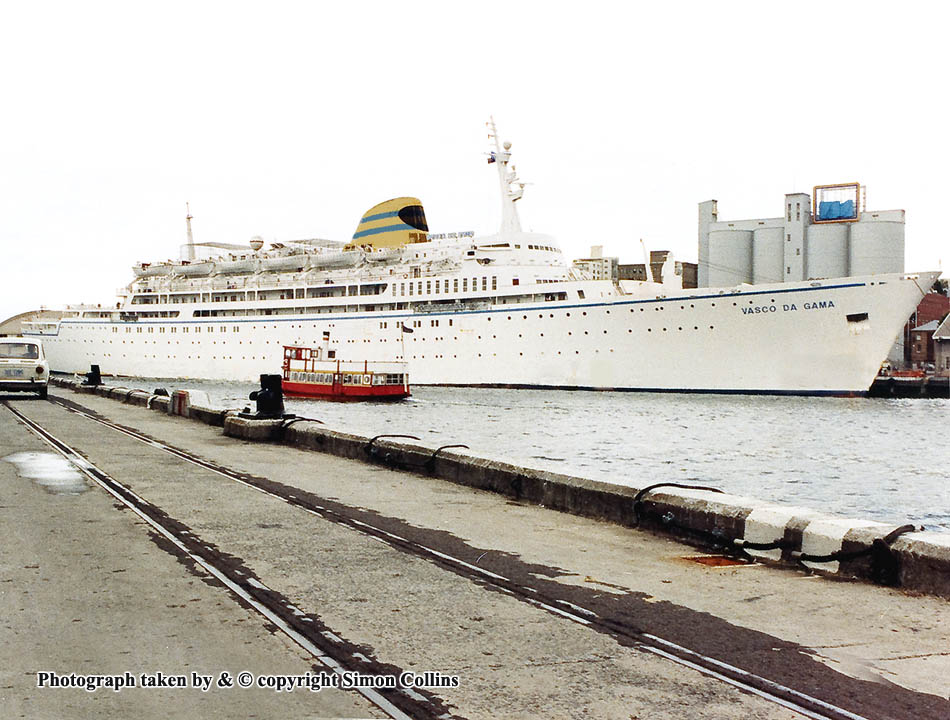Please Note: Firefox and some other search engines are not suitable
– Use “Internet Explorer” for this page to load perfectly!
50-Years in the
Passenger Shipping Industry
“Cia
Portuguesa de Transportes Maritimos”
TS Infante Dom Henrique
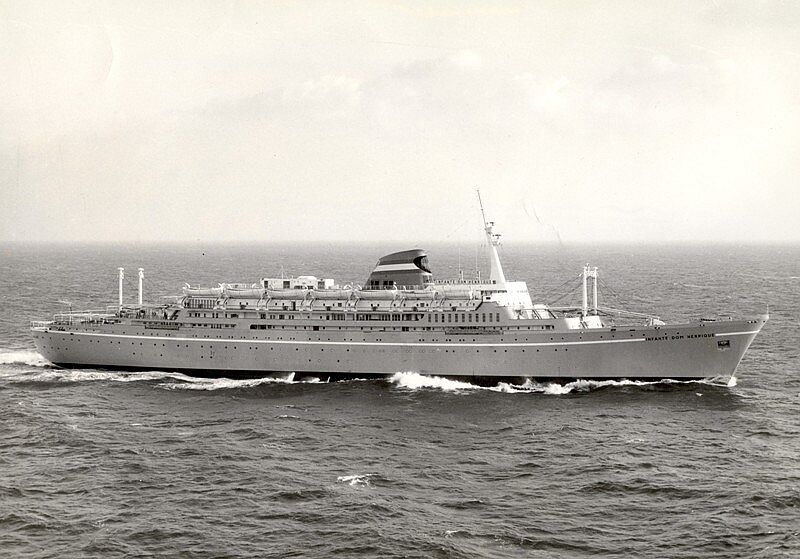
She was certainly an ultra modern and sleek looking liner for her time
Photographs are either from the author’s private collection or those that have been provided to the author by ssMaritime supporters, although the owners are not known. Please read the photo notes at the bottom of this page. A special thanks to Stan Evans and Jose Ponos for images provided.
Introduction:
There was no doubt that in the early
1960’s there was a resurgence of new passenger liners built for the
various services around the world. Be it, Union Castle Lines, superb SS Windsor
Castle in 1960, Orient Lines, SS Oriana in 1960, P&O’s SS Canberra in
1961, French Line SS France in 1962, followed by so many other notable liners,
such as Zim Lines SS Shalom, and the great Cunard
liner SS Queen Elizabeth 2, just to name a few, however there were countless
great ships built during this time including some super Italian liners
including the Lloyd Triestino Lines TN Galileo and
Marconi in 1963. However, in
Her Beginnings:
The TS Infante Dom
Henrique was
She was completed and delivered to her owners
in September 1961 some seven and a half months after the terrible hijack of the
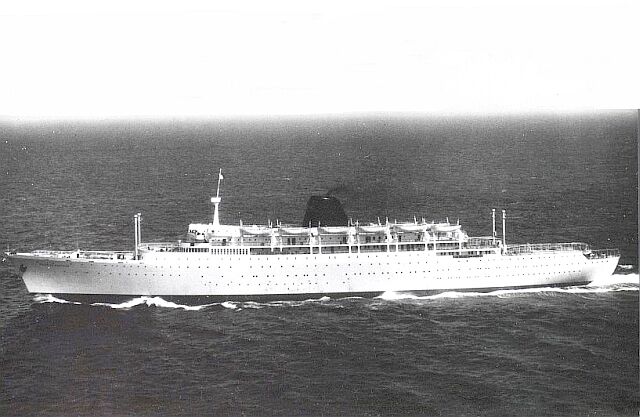
TS
Principe Perfeito is seen at full speed ahead at sea
After
various guises she was broken up in India 2001
With the Infante Dom
Henrique having been completed, in February 1961, she undertook her sea trials
in the
She was delivered to her owners on September
21, 1961, and finally departed on her maiden voyage on October 4, sailing from
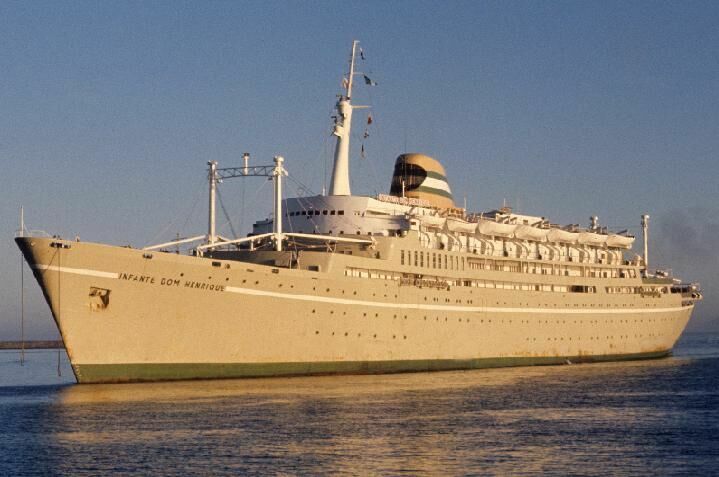
Her
hull colours was taken up to the top of Promenade (A) Deck
Being
a new and a different approach, giving her an unusual look
In September 1963, no less than Portuguese
President Thomaz sailed on her for an official
voyage, an honour bestowed only on two other ships the SS Funchal and the
Companies other ship the Swan & Hunter & Wigham
Richardson,
The Ships Facilities:
Unlike her earlier sisters the company had decided on some radical changes when they designed this ship, both externally, as she “looked as modern as tomorrow” as the saying went at the time, to even “futuristic.” And her sleek looks and her unusual colour arrangements certainly gave her a new and unusual look! However, it would be her interiors that would see some dramatic changes from the “old times” and she would become a ship with the “new look.” Gone were the dark panelled lounges and the garden verandas. Her First Class although spacious for just 156 privileged passengers, the majority of the ship was made available to the 862 Tourist Class passengers.
In addition, instead of carrying three or four classed she only offered two classes, First and Tourist. Although they there was a Tourist Class A, and Tourist Class B. This that Tourist A offered a cabin amidships, whereas Tourist B was a cabin aft of the ship. Her First Class was referred to as the “Penthouse” covering, Games, Boat, A (Prom) and B Decks 4 Decks). But First Class staterooms were located on just two decks, whereas Tourist Class cabins were spread over three decks, but two lower ones covering almost the full length of the ship.
The décor was very much of the late modernistic fifties, with a great deal of steel and glass, with pastel colours combined with stark dark tones. Flooring had gone mostly to vinyl and timber wall cladding was only used in moderation. Yet, she had a unique look and the Infante Dom Henrique became a popular ship with both her First and Tourist Class passengers.
Like her earlier sisters she offered three fine decks for walking outdoors along the side of the ship, with one being a full walk around deck. Let us look at her deck by deck”
Boat Deck: Forward, one on the starboard, the other on portside, were two magnificent deluxe suites. In addition there were another 36 superior twin and single staterooms all with private facilities. Located just forward of the main stairwell was the chapel, whilst far aft out on deck was the First Class Swimming Pool complete with a bar and the Sun Deck. Whilst the deck above was First Class Sports Deck that ran the full length of the superstructure.
A (Promenade) Deck: This is obviously the Promenade as it had full length windows forward. This deck was devoted to the main public rooms. Forward was the First Class Main Lounge, then the superb and elegant Lobby featuring the statue of the famed statesman Infante Dom Henrique. This was followed on the starboard side by the Library and the Reading Room whilst on portside there was the Writing Room. The next lounge amidships was the spacious Smoking Room and Bar. Then on the starboard side was the Children’s Playroom and this ended the First Class section of A Deck inside as well as outside out on deck. Portside there was the Tourist Class Children’s Playroom, followed by the Tourist Smoking Room and Bar with their swimming pool and terrace bar outdoors.
B Deck: The forward section offered 58 First Class staterooms, all were twin bedded or single bedded, and all First Class staterooms had private facilities and were outside, thus had an oceanview! Here we find the top level of the ships main First Class spectacular two level vestibule/lobby this level offered the shops. B deck offered the highest grade Tourist Class cabins with private facilities. Aft of the accommodations was Main Lounge Ball Room, which continued to the Bar on the starboard side and the Gallery portside. Outside there was ample open deck space for both classes. The Tourist Class Lobby also had its shops there.
C Deck: Forward was the Grand Lobby, the Pursers Office and the ships entrance. Here the passengers would also enter the First Class Dining Room. There were no more cabins on this or any other level. Aft of the Galley, was the Tourist Class Dining Room, which was more than twice the size of First Class. This was followed by their large Main Lobby and Pursers Office. The ships hospital and the doctor’s surgery was located aft. D Deck and E Deck was occupied with Tourist Class (outside and inside) cabins, none of which had private facilities.
Photo Album
First Class
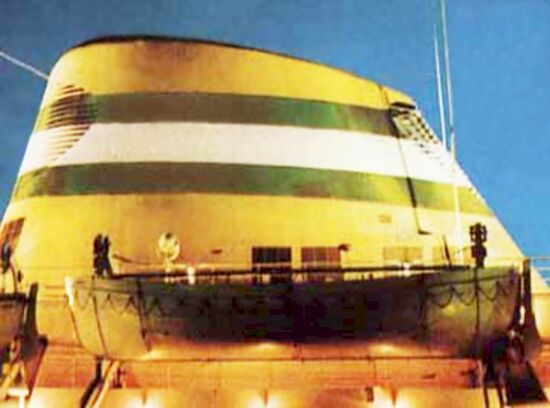
The
ships stylish funnel
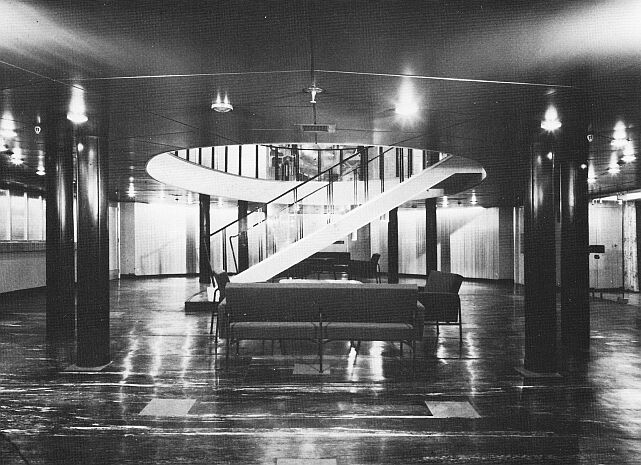
The
Grand Lobby forward on C Deck, looking to starboard with the Pursers Office on
the left
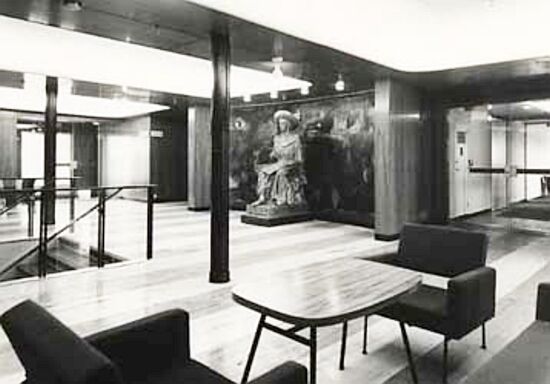
This
is the Main Lobby and stairwell just aft of the Main Lounge
It
featured the statue of Infante Dom Henrique
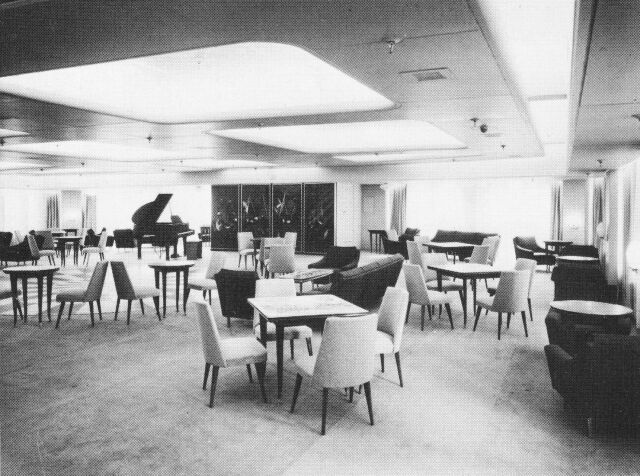
The
Main Lounge
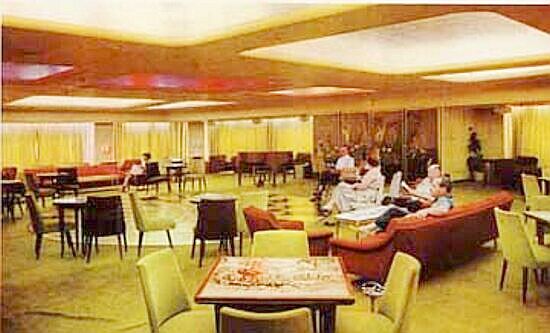
A
colour image of the Main Lounge
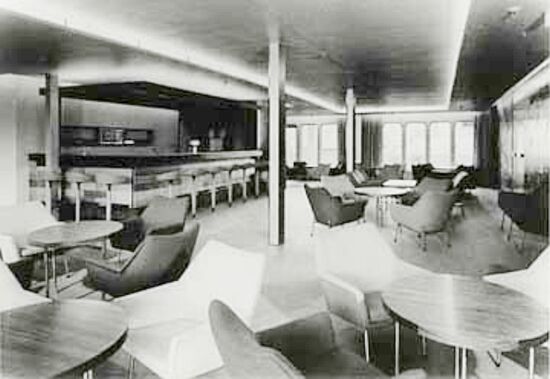
The
Smoking Room Bar
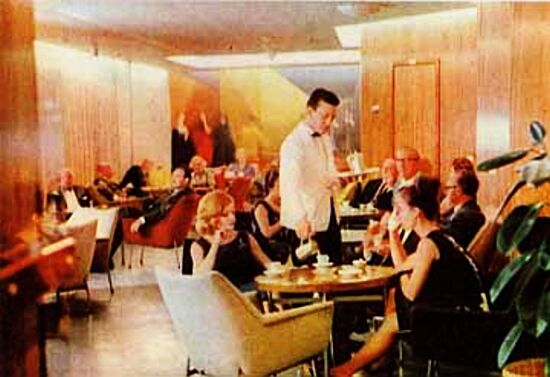
A
colour image of the Smoking-Room
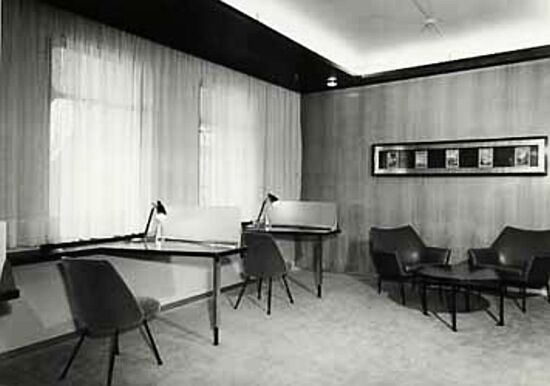
The
Writing and Reading Room
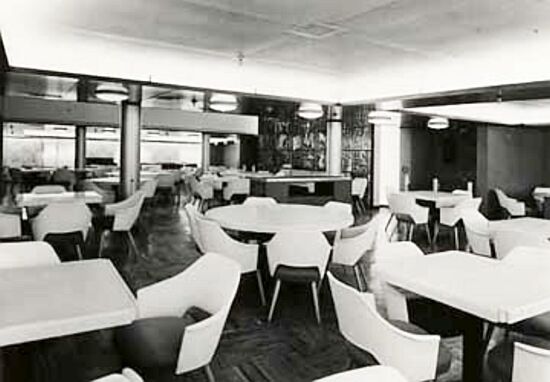
Dining
Room
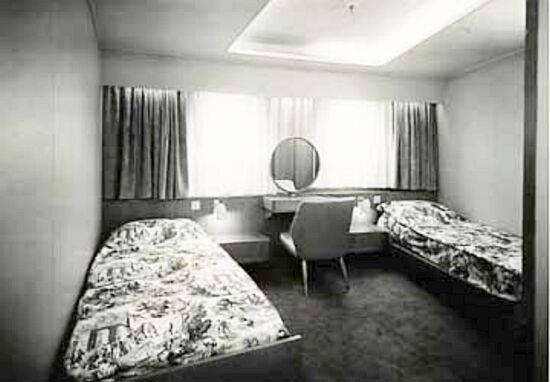
A
typical; twin bedded cabin
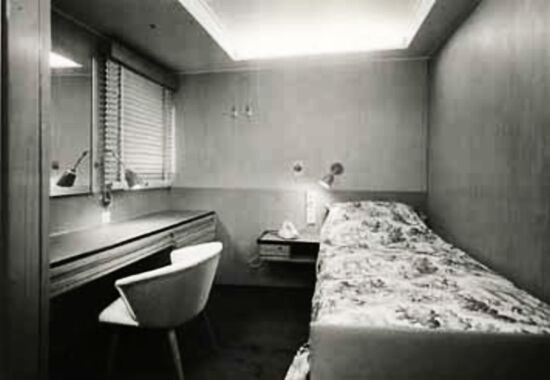
A single bed cabin
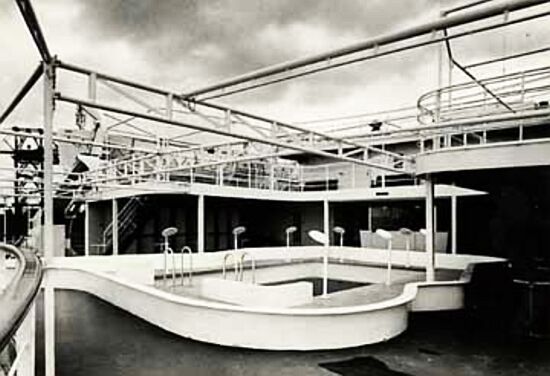
The Pool
Tourist Class
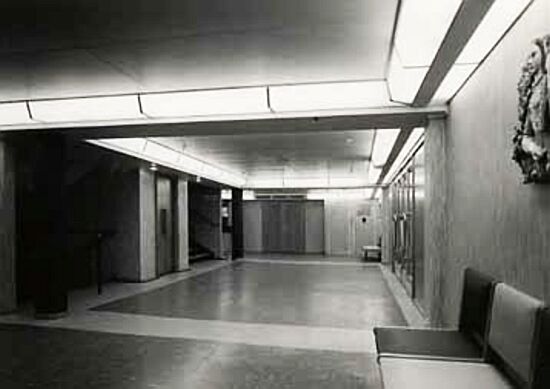
The
Main Lobby
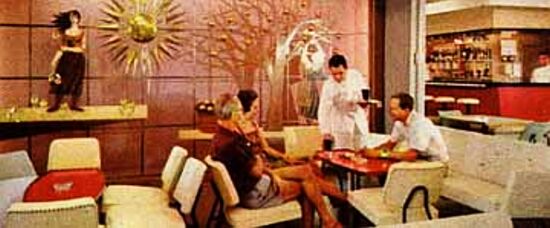
The
Smoking Room and Bar
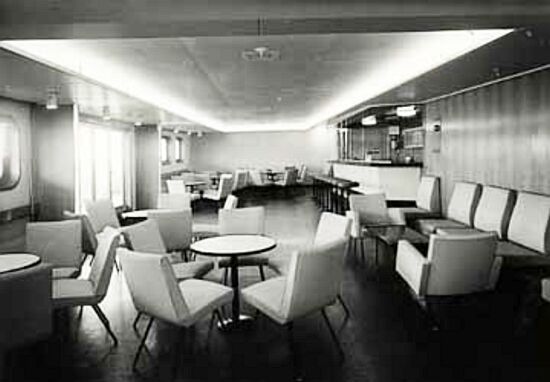
“The
Bar
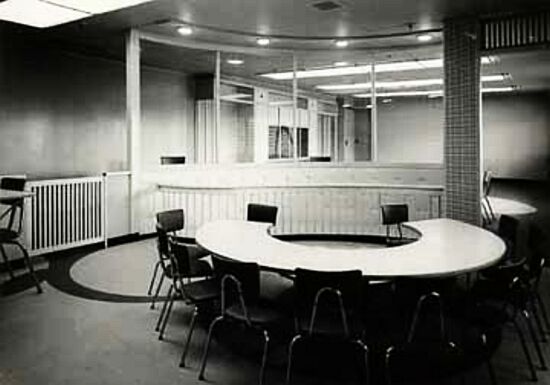
Children’s
Play
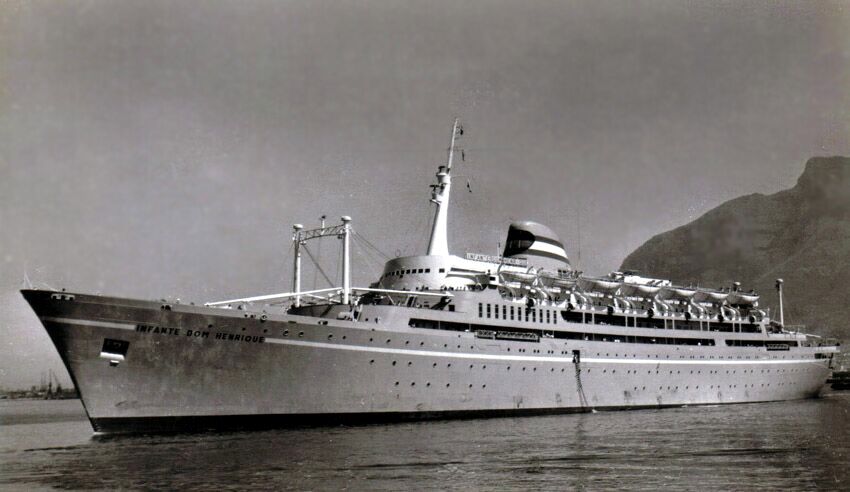
The
elegant looking TS Infante Dom Henrique
Photograph by Mr. R Varns
Times are
‘a’ Changing?
In
1974 the company name was changed to “Cia
Portuguesa de Transportes Maritimos”,
which came abut due to an amalgamation with two relative companies. However,
she continued on her regular services until January 3, 1976, when she was laid
up in
Specifications as Built:
Builder: J. Cockerill
Ship-building Ltd,
Built for: Companhia Colonial De Navegacao.
Launched: April
29, 1960.
Maiden
Voyage: September 21, 1961.
Tonnage: 23,306
Length: 195.5 m / 642 ft.
Width: 24.4 m / 80.4 ft.
Draught: 27 ft.
Propulsion: Westinghouse type D.R. geared
steam turbines – 22,000
Screws: Twin.
Service
speed: 20 knots.
Passengers: First Class: 156
Tourist Class
A: 384 – Tourist Class B: 478.
Crew: 318.
Port
of registry:
Livery: Grey/green hull, white
upper superstructure, yellow funnel with green and white bands.
Green boot topping.
Holds: 4, capacity of 10,504 cubic
meters of general and refrigerated cargo.
1977 to 1986:
Having
been laid up, she was eventually sold to a group named - “Gabinete da Area de Sines”
(
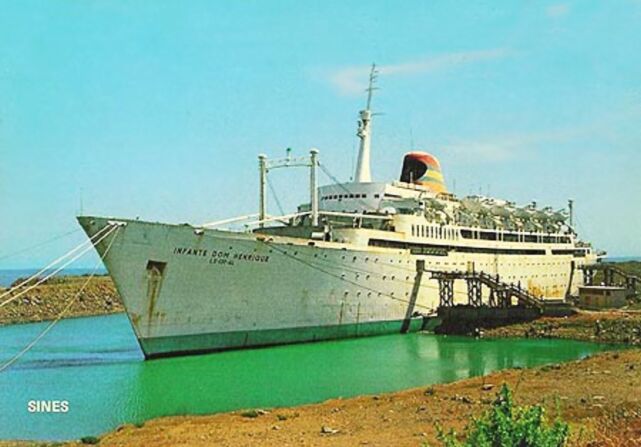
This
is a postcard that was issued of the Infante Dom
Henrique seen berthed in her basin at Sines
The
time came that ship was partially covered with rust and the paintwork on her hull
and superstructure was slowly beginning to peel away, it looked as though the
ship that was once considered as the superb and ultra modern TS Infante Dom Henrique was going to be doomed and that her
future was most likely the breakers.
Vasco Da Gama – 1986
– 1997:
However,
fortunately in 1986, the badly neglected Infante Dom
Henrique came to the notice of the famed Lisbon-based Greek shipping magnate;
Mr. George Potamianos of one of the most respected Portuguese Shipping
organisations to this day, Arcalia Shipping of
Lisbon, and he decided to purchase the ship for he could see for her and that
she was suitable to become a full time cruise ship. His plans were to fully
refit this badly neglected liner for his Panamanian registered company
“Trans World Cruises.”
As
her propellers had been removed at Sines, she was
towed from her basin back to
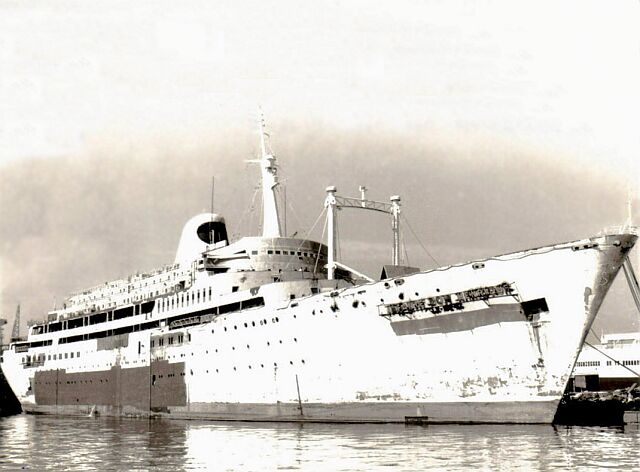
Infante being transformed in
Other
work that was undertaken was that her engines were completely overhauled.
Externally she seemed to look even better than before, which was mostly due to
the removal of her forward and aft king posts and derricks. In it place was a
small electric crane with a short mast behind it, A tall modern radar atop the
Bridge and a superbly styled aft mast at the rear of Sports Deck.
When
the work was completed the renamed Vasco Da Gama commenced in her new role as a
full time cruise ship. Having been chartered by the giant West German travel
organisation, “Neckermann Reisen,”
she commenced cruising from
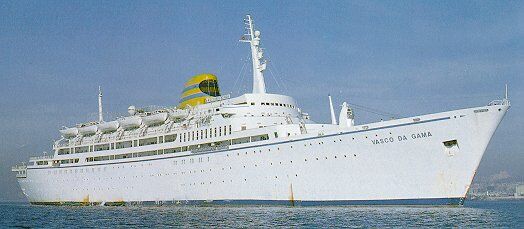
A
delightful small image of the beautifully rebuilt TS Vasco de Gama

A
fine aerial photo of the Vasco Da Gama
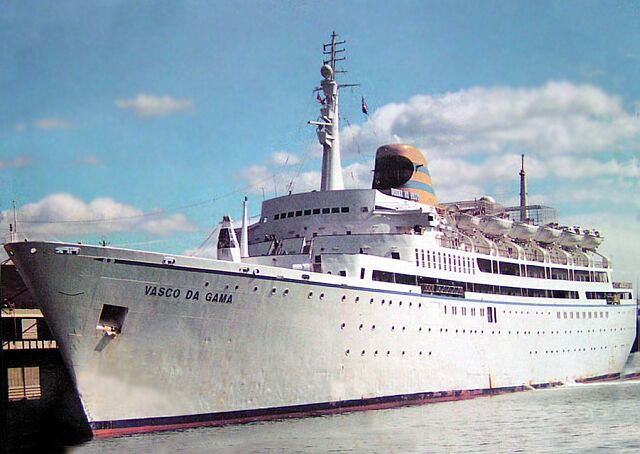
Here
we see a great classic ship
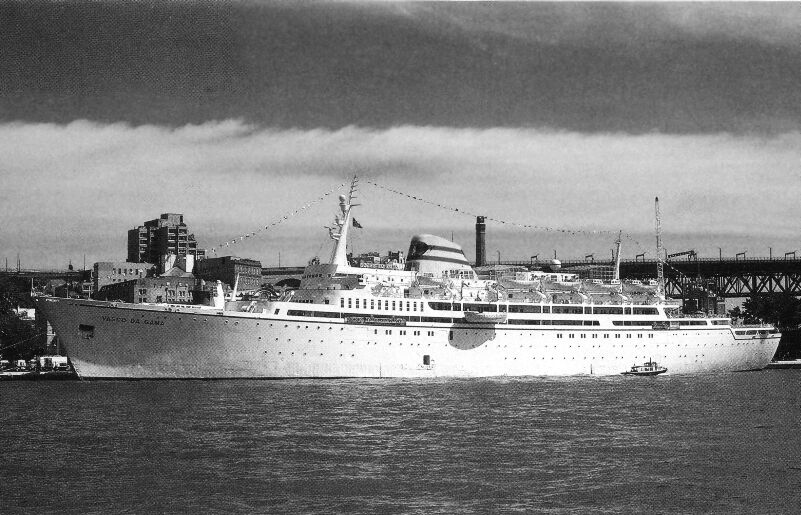
Two
days later she departed for
TS Vasco Da Gama is seen berthed in Hobart on March
12, 1989 - Photo by & © Simon Collins
Click the image above for a large version of Simon’s photograph when the new
image opens it will reduce
SS
Vasco de Gama - Photo Album
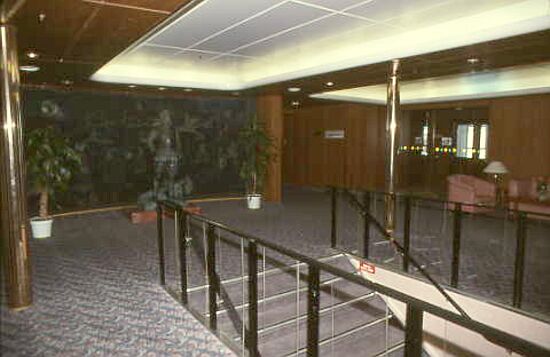
The
forward Lobby and stairwell with the surviving statute of Infante
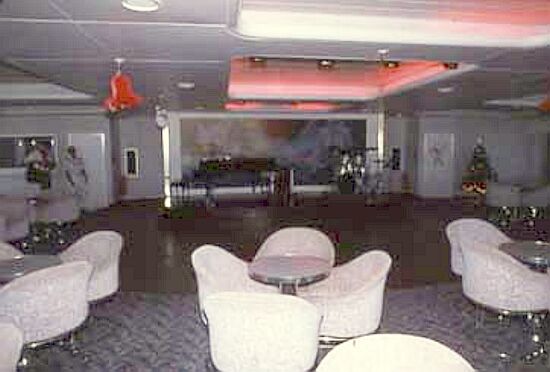
One
of her lounges
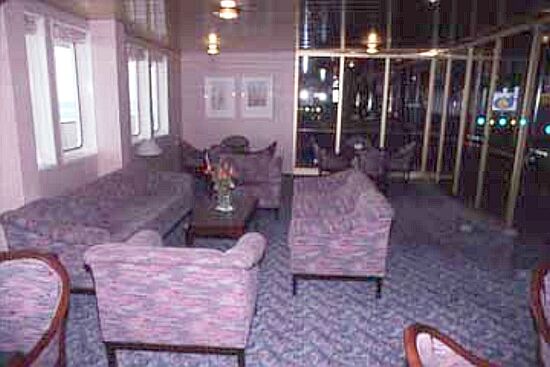
A
corner of a lounge
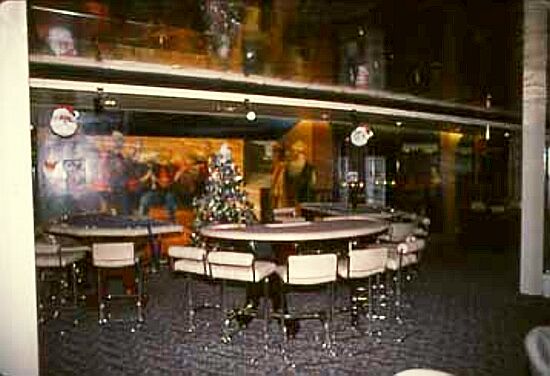
The
Casino
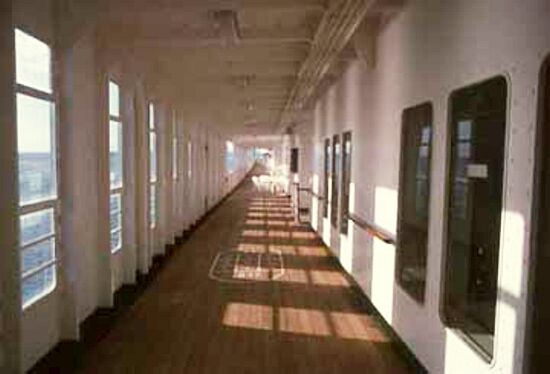
Starboard
Promenade Deck
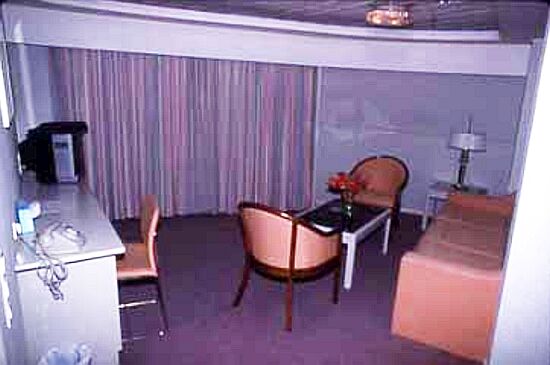
Lounge
section of one of the suites
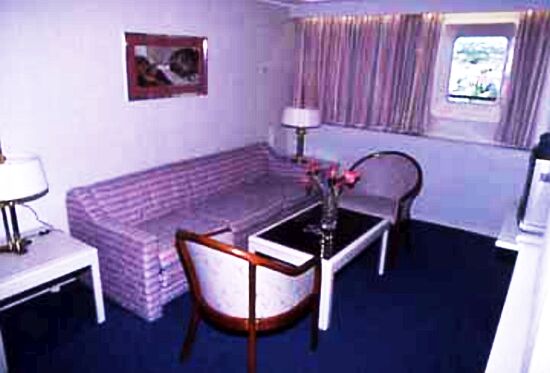
Part
of a deluxe cabin
After her visit to
SeaWind Crown – 1991 – 2003:
In 1991, Vasco Da Gama commenced on a series of Brazilian cruises, but she was given the additional name of SeaWind Crown (but officially she retained her original name on her bow) as she was under charter to the American “SeaWind Cruise Lines” and they mostly operated week long cruises to Aruba.
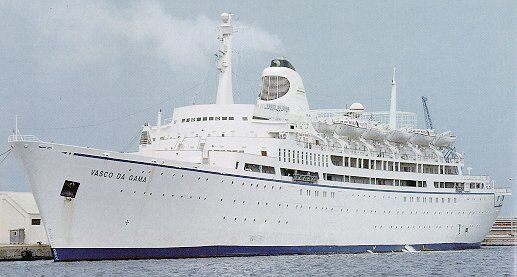
Although
the name says Vasco Da Gama on the bow, she had now been renamed SeaWind Crown
SeaWind Cruise Lines and their new vessel seemed to be a success in this
new market operating her seven night voyages with ports of call at Curacao,
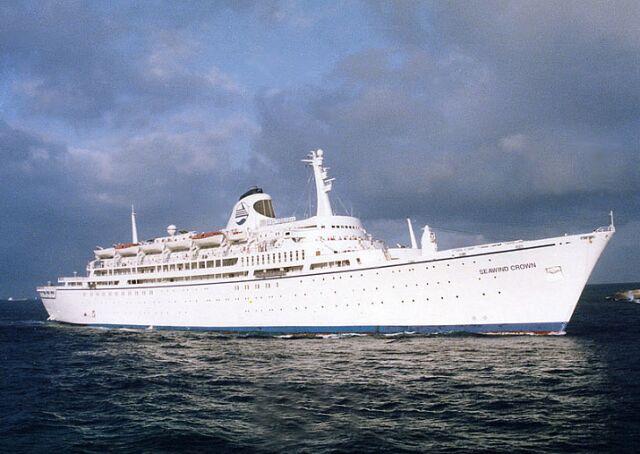
An
excellent photo of the SeaWind Crown and she looks
great in her all white livery!
Then in 1997, SeaWind and Dolphin Cruise Lines decided to merge which formed a new company “Cruise Holdings, Ltd.” By doing this they were initially able to keep their identities separate. But it would not be long before Cruise Holdings acquired all off Premier Cruise Line’s operations, which then merged all three companies under the new banner of “Premier Cruises, Inc.” SeaWind Crown was sent for a major refit towards the end of that year to make her ready with the new SOLAS (Safety Of Life At Sea) regulations and she received further drastic changes such as the replacement of her forward dining room and conference room with shops as well as cabins. Additional cabins were built were crew areas were on forward section of Atlantic Deck and there was an expansion of the Tavern into a Lido Restaurant the end of the original Nightclub. Upon completion her accommodation changed from 624 to 728. Externally she received a blue hull with a gold band surrounding it up high as well as a dark blue funnel with the Premier logo.
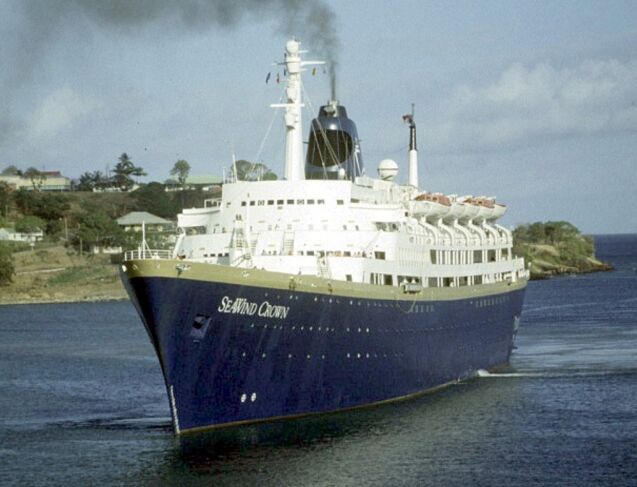
Sadly her days were running out for Premier
made many errors, such as taking her off the
Late in 1999 SeaWind
Crown was transferred from her successful Aruba base to
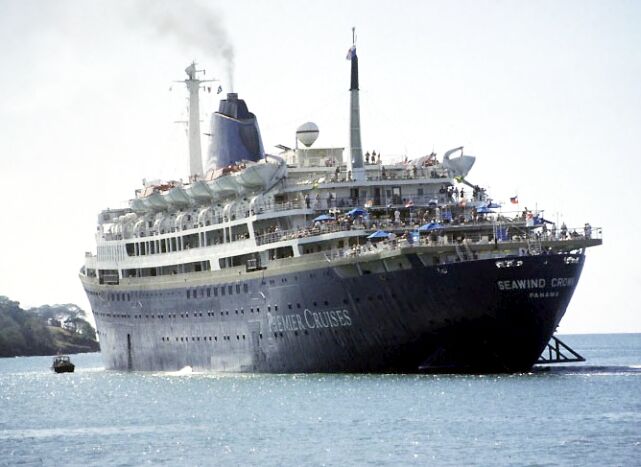
Both the SeaWind
Crown and her cruises were going well and Pullmantur was happy to keep her in
operation, when suddenly the worst possible event for this once great liner
could happen. The ships owners Premier Cruises Inc, in September of 2000 with
all of its assets, including all their ships and the SeaWind
Crown, under charter to Pullmantur were seized for payment of debt. Thus when
the SeaWind Crown arrived at
There were all sorts of efforts to save this ship, but being unable for the crew to obtain their back pay from the ship's liquidators, being Price Waterhouse Coopers, the technical operation company, International Shipping Partners, or Pullmantur Cruises, the crew decided to stay on board the ship for almost six months, and it was due to the generosity of various charitable organizations and individuals who not only donated food but sufficient funding for them to eventually go home. Sadly this magnificent ship was tied in “legal red tape,” although she was for sale, there were no buyers, thus the superbly beautiful SeaWind Crown was moved from the World Trade Centre Terminal in Barcelona harbour to a lonely berth near the outer breakwater and was laid up.
The Final
Year – 2004:
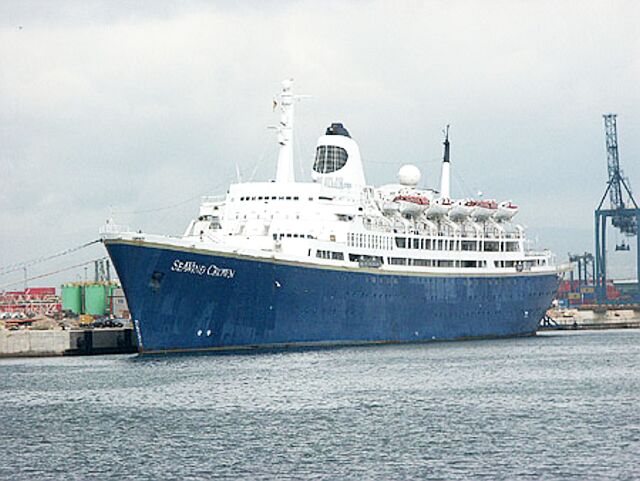
This
photo was taken in 2002 whilst laid up in
The Barcelona Port Authority now took control
of the ship, and with the berth space needed for an oil tanker facility, they
decided to place the renamed
It would be on December 28, 2003, that the
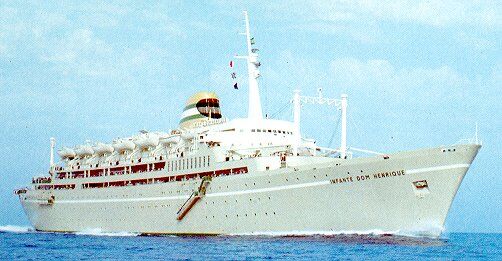
But she also
proved to be a Beautiful Cruise Ship!
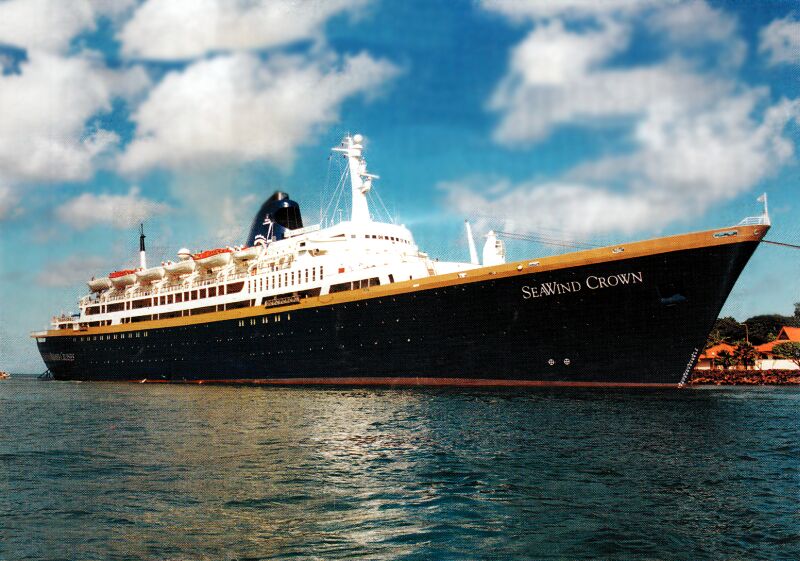
No matter under
which name she may have sailed - like so many other fine ships
This beautiful
ship may now have gone … But she will never be forgotten!
Enter
the TS Infante Dom Henrique Deck Plan
Also read: TS Santa Maria - TS Vera
Cruz & SS Funchal
***********************************
Return to the ssMaritime MAIN INDEX
ssMaritime.com & ssMaritime.net
Where the ships of the past make history & the 1914 built MV Doulos Story
Also visit the …
“Save The Classic Liners Campaign”
Please Note: ssmaritime and associated sites are 100% non-commercial and the author seeks no funding or favours of any shape or form, never have and never will!
Photographs on ssmaritime and associate pages are by the author or from the author’s private collection. In addition there are some images that have been provided by Shipping Companies and private photographers or collectors. Credit is given to all contributors. However, there are some photographs provided to me without details regarding the photographer/owner concerned. I hereby invite if owners of these images would be so kind to make them-selves known to me (my email address may be found on www.ssmaritime.com only), in order that due credit may be given.
This notice covers all pages, although, and I have done my best to ensure that all photographs are duly credited and that this notice is displaced on each page, that is, when a page is updated!
ssMaritime is owned & © Copyright by Reuben Goossens - All Rights Reserved

